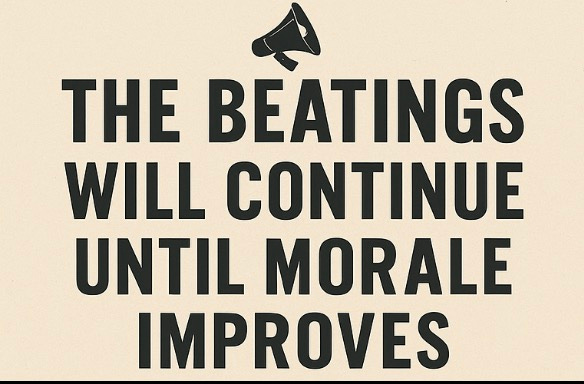The beatings will continue until morale improves
NHS England’s new mood is brisk: see 90% of “clinically urgent” patients the same day, push Advice & Guidance before referrals, and make 95% of appointments “available” via the app after triage. It’s sold as modernisation. It reads like punishment dressed as performance: the beatings will continue until morale improves.
When you turn general practice into an urgent care conveyor belt, you don’t create capacity; you reprioritise it—away from chronic disease, prevention and continuity. You hit a target by starving the long game. Patients don’t live in dashboards. They live with diabetes, frailty, depression and polypharmacy, and those do not yield to same-day theatrics.
What a single-minded same-day target actually does
A 90% same-day aim sounds clean. It isn’t. The quickest path is:
-Badging more things as “not urgent” and shunting them.
-Thinning out every contact until you’re doing medicine by postcard.
-Rewarding noise over need—whoever shouts “urgent” loudest wins.
You’ll still get queues—only now they’re invisible lists of “not urgent” problems that quietly worsen. That isn’t efficiency; it’s moving the mess off-screen.
Continuity isn’t a luxury, it’s the method
Continuity is how we keep people out of hospital, make better decisions with less faff, and notice the thing that doesn’t fit. It needs headroom and ownership. Urgent-hub logic kills that: anonymous rotas, transactional consults, nobody responsible for the arc of a patient’s story. The outcome is predictable: more attendances, more duplication, worse safety for the multimorbid and the anxious, and clinicians burning out while pretending this is “access”.
Chronic disease and prevention: the predictable collateral
You cannot “urgent” your way to controlled blood pressure, safe lithium, cervical screening uptake or decent foot checks. Those require protected clinics, recall systems and time to think. Cannibalise that time to feed a same-day metric and you’ll score a win on paper while haemorrhaging QALYs in real life. The bill turns up later—in A&E, on wards, and in social care.
Partnerships vs. archetypes: factories don’t build trust
Partnerships are unfashionable until you need accountability, memory and local problem-solving. Replace them with “model neighbourhood archetypes” and you get a factory: centrally designed, locally tolerated, owned by no one. Factories shift units; they don’t build relationships. When partnership pride goes, recruitment, retention and quality follow. And yes, morale keeps dropping—cue another beating.
“Advice & Guidance first”: rationing with paperwork
Used sensibly, A&G is brilliant. Mandated blanket-first for whole specialties, it becomes a toll booth:
-GPs write longer mini-referrals to justify the obvious.
-Consultants run unpaid triage clinics in their inbox.
-Patients wait while the clock cleverly doesn’t start.
That’s not demand management; it’s delay management. Bypass must remain a clinician’s call when it’s clearly appropriate.
The 95% App mirage
Making almost all appointments “available” via the app after triage confuses product uptake with clinical suitability. Plenty of people can’t or won’t navigate digital funnels; plenty of problems shouldn’t be squeezed through them. If your policy works for slick screenshots but not for safeguarding, neurodiversity, language barriers, or the chaotic reality of long-term illness, it doesn’t work.
Target worship and the doom-loop
We’ve played this game: set a shiny number, build a compliance industry, spawn perverse incentives. Staff learn the cheat codes; patients learn the magic words; leaders declare success while the ground truth rots. The service gets more brittle, not more resilient. And morale? Lower. So the beatings intensify.
A better offer (that might actually improve morale)
-Split the access goals. Resource and measure both “urgent today” and “continuity this month”. Don’t let one cannibalise the other.
-Make continuity count. Publish and pay against a continuity index at clinician and practice level, targeted to those who benefit most (frailty, serious mental illness, multimorbidity).
-Ring-fence proactive care. Protected sessions for LTC reviews, prevention and deprescribing—untouchable when the daily noise spikes.
-Treat A&G as a tool, not a wall. Encourage its use, audit delays and outcomes, and preserve a clear, clinician-led bypass.
-Fix inputs, not just outputs. Workforce, estates, diagnostics, admin capacity and modern telephony matter more than any access slogan.
-Measure what patients feel. Time-to-third-available appointment, resolution on first contact, and ability to see a preferred clinician are better than raw same-day counts.
Bottom line
If you turn general practice into urgent care, you’ll get urgent care: fragmented, transactional and expensive elsewhere. You won’t get safer medicine, healthier populations or happier teams. Build for timely access and continuity, fund the boring foundations, and trust clinicians to exercise judgement. That’s how morale improves. Until then—let’s be honest—the beatings will continue.



